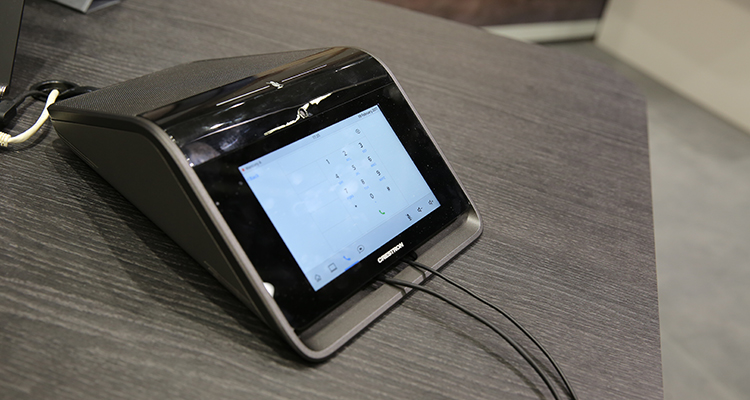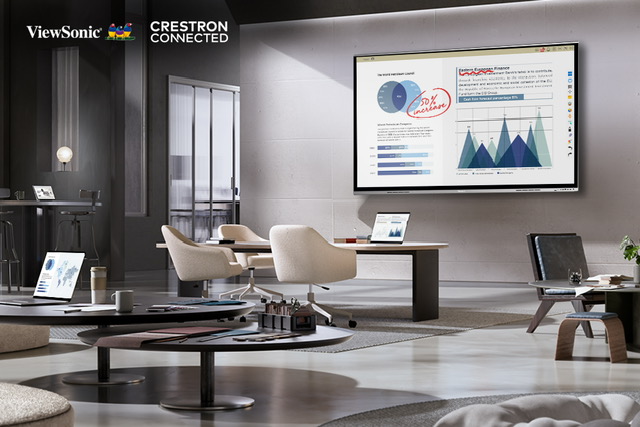At ISE, Crestron Goes Big (and Small), and Biamp Steps Towards Dante
Editor’s Note: Leonard Suskin has additional thoughts on Biamp’s TesiraFORTÉ DAN, which you can read here.
ISE has never been quite as big to me as InfoComm, though not for any particular reason. Perhaps it’s that time-zone differential is even worse heading East across the ocean than West to Las Vegas [or due South to Florida]. Perhaps it’s that most of my friends and contacts in the industry are American and more likely to be at InfoComm, even if I’m not. That said, it’s important to always have ones pulse on the industry. On that note, here are a few takeaways from the opening days of ISE:
Crestron Is Thinking Small
The biggest splash this week in distant Amsterdam should belong to my neighbors from New Jersey with not one, but two interesting announcements.

On the “small” side is the introduction of Mercury — essentially a USB/SIP speakerphone with, at the very least, a wireless video gateway and small touchscreen. Why is this interesting? Because there are still a host of smallish collaborative spaces from which we in the AV industry are largely shut out; for the purpose of audio-conferencing, a four, six, or even eight-person meeting room can often be served as well by a speakerphone in the middle of the table as with an integrated AV system. Replacing the speakerphone with an AV device brings us back into those spaces and puts that much more of the conferencing into our scope, where we want it.
This is another approach to the same challenge Biamp answered with their Devio tool; what do we do with collaboration and communications, which are moving away from our sphere of influence? This is distinct from the video to USB bridge products from Vaddio, Extron, Marshall and others. A USB bridge lets users bring software tools into the integrated AV environment. Discrete tools like the Devio and Mercury let users bring a quality AV experience out of the integrated spaces and into smaller, simpler rooms.
The Crestron solution is the most interesting from a traditional AV vendor into this area that I’ve seen; it isn’t just a speakerphone, but it’s a speakerphone with the kind of technology that we’ve come to associate with AV spaces. It’s the single-device conference-room solution for the smallest and most often overlooked spaces. This is the most interesting thing I’ve seen from Crestron in quite some time.
Crestron Is Thinking Big
 The other splash from Crestron — and one which I didn’t expect [yes, I know that I’m easily surprised] is the introduction of a JPEG2000 video over IP solution: NVX. This is interesting in that it’s Crestron’s first foray into the kind of low-latency visually-lossless IP distribution that can replace HDBaseT for point-to-point transport in large systems. A week ago, Crestron’s design direction was to use HDBaseT for in-room transport and H.264 for broadcast or overflow to serve a wider area. This isn’t a bad solution for most environments, but there are clear advantages to IP distribution in larger systems, particularly those with asymmetrical input/output counts. That Crestron is stepping into this arena closes what had been one of the few gaps in their video distribution ecosystem.
The other splash from Crestron — and one which I didn’t expect [yes, I know that I’m easily surprised] is the introduction of a JPEG2000 video over IP solution: NVX. This is interesting in that it’s Crestron’s first foray into the kind of low-latency visually-lossless IP distribution that can replace HDBaseT for point-to-point transport in large systems. A week ago, Crestron’s design direction was to use HDBaseT for in-room transport and H.264 for broadcast or overflow to serve a wider area. This isn’t a bad solution for most environments, but there are clear advantages to IP distribution in larger systems, particularly those with asymmetrical input/output counts. That Crestron is stepping into this arena closes what had been one of the few gaps in their video distribution ecosystem.
The NVX appears to be — on paper — very similar to JPEG2000 products I’ve seen from SVSI, Just Add Power and others. In addition to routing an arbitrary count of inputs and outputs, the NVX series will include the kind of basic video-wall routing, text and graphic overlays, and similar features which we’ve come to expect from this class of product.
What’s most interesting about this is that Crestron doesn’t appear to see this as an either/or. They’re still expanding their DM-family of products with a 4K version of the now-venerable DMPS-300 series. There are reasons this makes sense, but that’s another post. This was, for my money, a very interesting show from Crestron.
Everyone Has a Digital Whiteboard
 The one thing Crestron does not yet make is a digital whiteboard. That’s OK, as nearly everyone else appears to be offering one. We still have industry veterans SMART Technologies, the Microsoft Surface Hub, and now the Cisco Spark Board (and, from outside of ISE, the Google Jamboard). These products have become very similar — gateways to ecosystems. The Google Jamboard ties into Google apps, the Surface Hub into Skype for Business and similar Microsoft applications, etc.
The one thing Crestron does not yet make is a digital whiteboard. That’s OK, as nearly everyone else appears to be offering one. We still have industry veterans SMART Technologies, the Microsoft Surface Hub, and now the Cisco Spark Board (and, from outside of ISE, the Google Jamboard). These products have become very similar — gateways to ecosystems. The Google Jamboard ties into Google apps, the Surface Hub into Skype for Business and similar Microsoft applications, etc.
The potential threat is to those standalone devices without their own set of widely-adopted applications. I can foresee the “default” option being to choose the device which fits one’s organization.
The all-in-one touch-enabled whiteboard is, in its way, the higher-tech, higher-cost answer to the question Crestron answered with the Mercury speakerphone at the beginning of this post: What do we do with small, low-cost collaborative spaces? For many clients, I suspect that the speakerphone option is the more easily adopted one; dialing what looks like a desktop phone is easier and more familiar than even the simplest touch-enabled LCD devices. These devices certainly have a place, but it’s a bit of a niche.
Biamp Steps Towards Dante

Biamp made one of their rare missteps quite a few years ago when they chose AVB over Dante as the primary vehicle for audio transport within their then-new generation of DSP devices. Today they’ve added Dante to their TesiréForte line of products, removing the biggest hurdle to using the product in smaller rooms with third-party endpoints. AVB still forms the basis of their video-transport Tesira Lux product line with the time-synchronization advantages therein.
What does this mean? It means that Biamp can now compete in mid-size spaces with, for example, a Shure MX910 ceiling microphone. It means that the wide, wide range of third-party Dante I/O devices can be used with the smaller Biamp DSP devices as well as the larger Tesira Server models.
We’ll see what else comes from the show, and what more will come this summer in Orlando. Perhaps I’ll be there in meatspace for once, or perhaps I’ll be where I’ve been for the past two years, watching from a distance.





